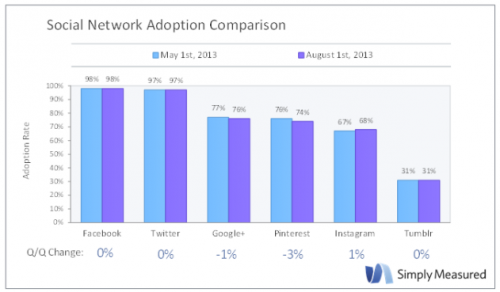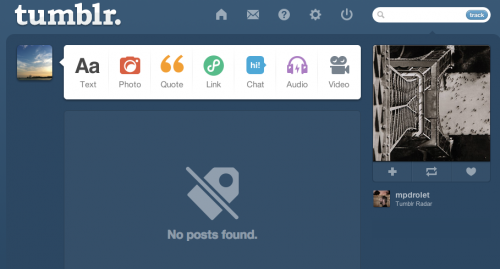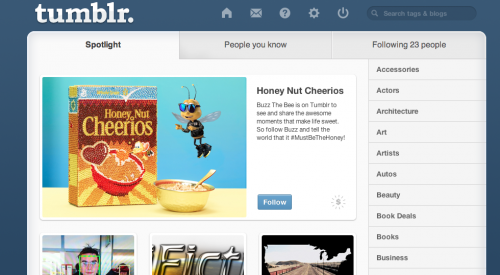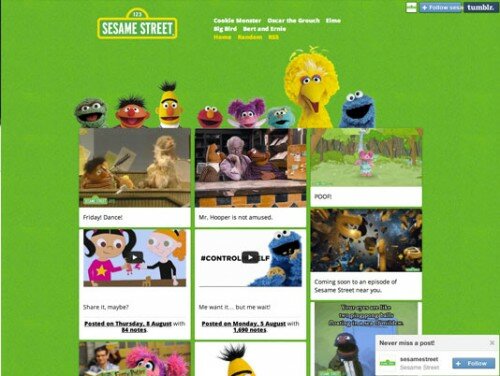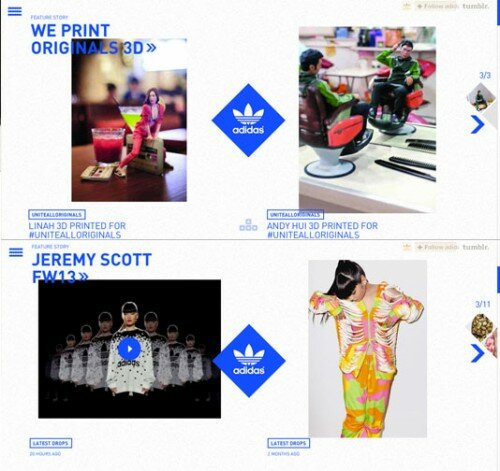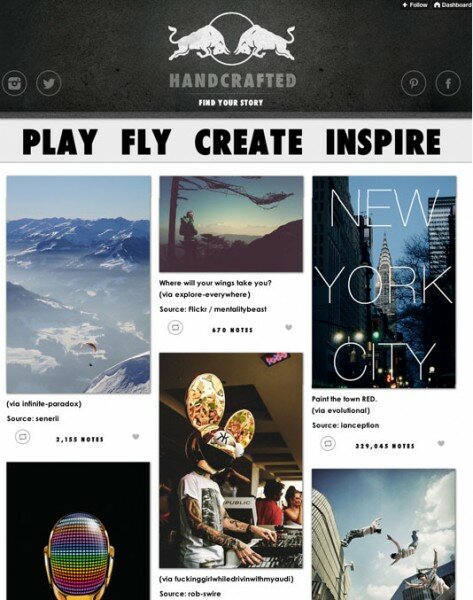All the stats look positive so why is it that out of Interbrand’s 100 only 31% have a Tumblr presence, with 21% of them active?
This falls way behind brands’ presence on Facebook (98%), Twitter (97%), Google+ (76%), Pinterest (74%) and Instagram (68%) and yet social media analytics company, Simply Measured’s research suggests that Tumblr could greatly benefit brands’ engagement with posts having the longevity normally associated with YouTube videos, rather than Facebook updates. Simply Measured studied the Top 100 Brands on Tumblr from 5th July to 4th August 2013 to understand how successful brands were using this platform.
In the UK especially, social media strategies rarely include Tumblr as a means of social engagement. US brands on the other hand, whilst not quick to jump onboard, have been seeing success with their levels of engagement and reach.
“Of the 31 brands with accounts, there is an average of 1,462 notes per post.”
– Simply Measured
What is ?
Co-founder, David Karp, had been interested in ‘tumblelogs’ or short-form blogs, and tired of waiting for one of the established blogging platforms to extend its offering to short blog facilities, developed his own, along with Marco Arment. So, in February 2007, Tumblr was launched.
Tumblr is free to set up, with thousands of free themes to choose from and customize. Similarly to most other social networks, users can upload text posts, images, videos, quotes or links and they can also comment, like posts from other blogs and perhaps, their most important feature for brands, re-blog content from other Tumblr blogs to their own. Tumblr refers to engagement as ‘notes’, and these include liking a post, commenting on a post and re-blogging.
Users are also able to add tags, similar to Twitter hashtags, that enables their audience to discover specific content, plus users can queue blog posts up to publish at a chosen day and time (something that can only be done on Twitter and Facebook when using a third-party publishing tool).
Tag pages are pages that are dedicated to a tag. So for example, you can set up a tag page for #cutecats and it will automatically pull in all content tagged with #cutecats, working in a similar way to Instac.at. In July 2013, Tumblr updated its policy so that users who aren’t logged in or who have activated the ‘Safe Mode’ won’t see any pages classified as ‘NSFW’ (Not Suitable For Work) or ‘Adult’ showing up in their tag pages. If users don’t have ‘Safe Mode’ turned on, then blogs considered to have ‘adult’ content will show. However, such blogs are not indexed by Tumblr’s own search facility or third-party search engines, thus discouraging the use of adult content on its platform.
Why should brands consider Tumblr?
“A network of interests rather than people who know each other. This gives more flexibility and expression to your brand.“
– Mark Coatney, Tumblr’s former Media Director
Tumblr is a network of interests: this is one of the most important characteristics for brands. It’s not about who knows who, it’s about what people are searching for and what people are interested in. If you’re providing content around an interest or passion, as opposed to purely -pushing your product or service then you’ve taken the first step to success.
Tumblr is about fitting in –Tumblr is a demanding and opinionated community which is united in its desire for original, interesting and share-able content. They’re also savvy to marketing ploys and brands will need to really get to know the users and what drives them before sharing their own content.
Tumblr tags will help drive your content – Tags increase the discovery of your content. With Tumblr, brands have the opportunity not just to share content with their followers, but to a whole new audience. For example, if you’re a sports brand and a post is tagged #sport, you’ll immediately appear in tag pages for #sport, as well as users’ search results.
Re-blogs will give your content longevity – Facebook statuses are gone in an instant. So are tweets. Yet Tumblr’s re-blog functionality allows for posts to stay around for months.
Take a look at this post from the Sprite Tumblr account. It is an animated gif of a spin the bottle game.
![]()
Regardless of its apparent simplicity, it generated over 85,000 reblogs and received 123,676 Tumblr notes. And as the graph shows below this was a post that kept on travelling throughout July.
![]()
According to Simply Measured’s research:
- 29% of re-blogs take place AFTER 30 days
- Original content accounts for 89% of brand engagement
- 60% of re-blogs occur because of amplification
What are the potential pitfalls for brands on Tumblr?
There’s no advertising – but this could be considered a good thing. Tumblr has what are known as ‘sponsors’, with two option. The first is a direct link from your user’s dashboard showing an image from the featured user’s account, as well as their account name. This is known as Tumblr Radar.
also exists which consists of a large feature area with smaller ones underneath.
It is not clear just how users are featured as ‘sponsors’, but it is heavily suggested that accounts reach this Tumblr ‘Holy Grail’ through great content that is curated and hand-picked, rather than through any financial transaction.
Dedicated investment is a must – unlike other social media platforms, it’s not as easy to re-purpose content from Facebook or Twitter. Tumblr is a world of its own and the rules are very different; content will need to be created specifically for its users.
Choose your content carefully – Content drives Tumblr and there is no tolerance for shoddy craftsmanship on this platform. Brands will need to up their game and realize that attitude, edginess and inspiration packaged into photos, videos, quotes and quick-fire questions work best amongst the Tumblr audience.
The upside is that great content spreads fast, with the potential for likes, re-blogs and comments to reach the thousands, with a relatively small audience, allowing brands to quickly build up their audience.
What are the best brands on Tumblr?
Brands ‘win’ on Tumblr if they either have access to the type of content described above, or the ability to produce it. There seem to be a variety of industries that aremore suited than others to Tumblr, including fashion, which has a plethora of stimulating visuals to share, and media and broadcast channels with their never-ending supply of content. Some large companies, such as Mashable, use Tumblr as a ‘behind the scenes’ showcase.
Take a look at how some brands are using the platform to connect with their audiences.
uses Tumblr to showcase video snippets, animated gifs, quotes, retro Sesame Street material, as well as links to more serious content based around family statistics. It’s a mash-up of content that will delight audiences young and old.
is understated and minimalistic, and manages to ‘sell’ its products in a way that resonates positively with its Tumblr audience. It focuses on their Originals range and includes snapshots from the campaign, competition, upcoming products, competitions, links to articles, videos and featured stories, all graphically presented in a unique and intriguing way.
have cleverly optimized the re-blog functionality and taken ‘ownership’ for the tags ‘PLAY’, ‘FLY’, ‘CREATE’, ‘INSPIRE’. They post their own content, namely photos and videos, as well as re-blogging other pieces of relevant content to their own account.
Should you consider using Tumblr?
If you have the time and budget to create bespoke, value-added content for Tumblr, then yes, absolutely.
It’s certainly worth considering it as a platform to build audience engagement, but it goes without saying that you need to spend some time researching whether your potential audience is already there, so you can easily connect. You also need to consider whether your brand is in a position to provide high-quality visual content. It’s not a beaten track and there are fewer best practice guidelines, but on the upside, the audience will push your brand to giving the best it can.



